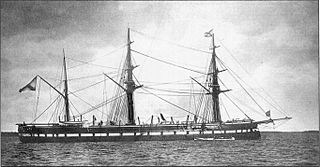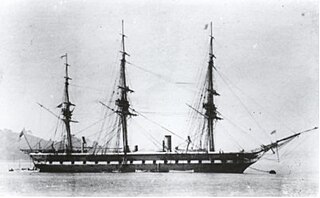
A ship of the line was a type of naval warship constructed during the Age of Sail from the 17th century to the mid-19th century. The ship of the line was designed for the naval tactic known as the line of battle, which involved the two columns of opposing warships manoeuvering to volley fire with the cannons along their broadsides. In conflicts where opposing ships were both able to fire from their broadsides, the faction with more cannons firing – and therefore more firepower – typically had an advantage.

An ironclad was a steam-propelled warship protected by steel or iron armor constructed from 1859 to the early 1890s. The ironclad was developed as a result of the vulnerability of wooden warships to explosive or incendiary shells. The first ironclad battleship, Gloire, was launched by the French Navy in November 1859, narrowly preempting the British Royal Navy. However, Britain built the first completely iron-hulled warships.

Steam frigates and the smaller steam corvettes, steam sloops, steam gunboats and steam schooners, were steam-powered warships that were not meant to stand in the line of battle. The first such ships were paddle steamers. Later on the invention of screw propulsion enabled construction of screw-powered versions of the traditional frigates, corvettes, sloops and gunboats.

HMS Duke of Wellington was a 131-gun first-rate ship of the line of the Royal Navy. Launched in 1852, she was symptomatic of an era of rapid technological change in the navy, being powered both by sail and steam. An early steam-powered ship, she was still fitted with towering masts and trim square-set yards, and was the flagship of Sir Charles Napier.

HMS Liverpool was a fourth-rate frigate of the Royal Navy.

The second HMS Mersey was commissioned in 1858, six years after the first Mersey had been broken up. She and her sister ship the Orlando were the longest wooden warships built for the Royal Navy. At 336 feet in length, HMS Mersey was nearly twice the size of HMS Victory, the flagship of Admiral Horatio Nelson at the Battle of Trafalgar. At 5643 tons displacement, she was certainly a large and impressive looking ship in her day. She was heavily armed, and in comparison to many of her counterparts was quite fast with an approximate speed of 12½ knots, achieving 13½ on trials.

HMS Caledonia was a broadside ironclad of the Prince Consort class. Originally laid down as a two-decker steam ship of the line of the Bulwark class, Caledonia was converted on the building stocks into an armoured frigate.
HMS Repulse was the last wooden battleship constructed for the Royal Navy.

HMS Alexandra was a central battery ironclad of the Victorian Royal Navy, whose seagoing career was from 1877 to 1900. She spent much of her career as a flagship, and took part in operations to deter the Russian Empire's aggression against the Ottoman Empire in 1878 and the bombardment of Alexandria in 1882. She was affectionately known by her crew as Old Alex.

HMS Victoria was a 121-gun screw first-rate ship of the line of the Royal Navy. She and her sister ship HMS Howe were the first and only British three-decker ships of the line to be designed from the start for screw propulsion, and were the largest wooden battleships of their time. Between 1860 and 1867 Victoria was in active service as flagship of Britain's Mediterranean Fleet under Vice-Admiral Robert Smart. She was paid off in 1867 without ever seeing combat, and was sold for scrap in 1893.

HMS Orlando was a Mersey-class wooden-hulled steam-powered screw frigate built for the Royal Navy from 1856 to 1858 but not commissioned until 1861. Orlando and her sister ship Mersey were the longest wooden warships built for the Royal Navy. At 336 feet in length, Orlando was nearly twice the length of Victory, the flagship of Admiral Horatio Nelson at the Battle of Trafalgar. At 5,643 tons displacement, she was certainly a large and impressive looking ship in her day. She was heavily armed, and in comparison to many of her counterparts was quite fast with an approximate speed of 12½ knots, achieving 13½ on trials.

HMS Inconstant was an unarmored, iron-hulled, screw frigate built for the Royal Navy in the late 1860s. Upon completion in 1869, she was the fastest warship in the world and was assigned to the Channel Squadron. Two years later the ship was transferred to the Detached Squadron for a brief time before she was paid off into reserve in 1872. Inconstant was recommissioned in 1880 for service with the Flying Squadron that circumnavigated the world in 1880–82. On the return voyage, the ship was diverted to Egypt during the Anglo-Egyptian War of 1882 and played a minor role supporting operations ashore. She was reduced to reserve again after her return and was served as an accommodation ship in 1897. Inconstant was hulked in 1904 and became a training ship in 1906. She continued in that role, under a variety of names, until she was sold for scrap in 1955 and subsequently broken up, the second-to-last surviving Pembroke-built warship in existence.

Jeanne d'Arc was a wooden-hulled armored corvette built for the French Navy in the late 1860s. She was named for Joan of Arc, a Roman Catholic saint and heroine of the Hundred Years War. Jeanne d'Arc participated in the Franco-Prussian War of 1870–1871 and remained in commission afterwards, unlike many of her sisters. The ship was condemned in 1883, but nothing further is known as to her disposition.

His Highness' Ship Glasgow was a royal yacht belonging to the Sultan of Zanzibar. She was built in the style of the British frigate HMS Glasgow which had visited the Sultan in 1873. Glasgow cost the Sultan £32,735 and contained several luxury features but failed to impress the Sultan and she laid at anchor in harbour at Zanzibar Town for much of her career. The vessel was brought out of semi-retirement on 25 August 1896 when she participated in the Anglo-Zanzibar War and was soon sunk by a flotilla of British warships. Glasgow's wreck remained in the harbour, her three masts and funnel projecting from the water, until 1912 when she was broken up for scrap.

The Russian ironclad Petropavlovsk was a 22-gun armored frigate in the Imperial Russian Navy during the late 19th century. She was originally ordered as a 58-gun wooden frigate, but she was reordered as an ironclad while under construction and subsequently converted into one. She served as the flagship of the Baltic Fleet during the 1860s and 1870s. The ship was decommissioned in 1885, but was not sold for scrap until 1892.

HMS Undaunted was a wooden screw frigate, the fifth ship of the name to serve in the Royal Navy.

SMS Kaiser was a 92-gun wooden ship of the line of the Austrian Navy, the last vessel of the type, and the only screw-driven example, to be built by the Austrians. She was built by the naval shipyard in Pola; she was laid down in March 1855, was launched in October 1858, and was completed the following year. The ship took part in the Second Schleswig War of 1864, but saw no action during her deployment to the North Sea. Kaiser did see action during the Seven Weeks' War two years later, during which she took part in the Battle of Lissa as the flagship of Anton von Petz, commander of the Austrian 2nd Division. Kaiser engaged several Italian ironclads simultaneously, rammed one—Re di Portogallo—and damaged another—Affondatore—with gunfire. In doing so, she became the only wooden ship of the line to engage an ironclad warship in battle.

The French ironclad Provence was the lead ship of her class of 10 armored frigates built for the French Navy during the 1860s. Commissioned in 1865, she spent the bulk of her career with the Mediterranean Squadron, often serving as a flagship. The ironclad played a minor role in the Franco-Prussian War of 1870–1871, blockading the North Sea coast of Prussia. Provence was decommissioned after the war, but was reactivated in late 1875.

SMS Lissa, named for the Battle of Lissa, was a unique ironclad warship built for the Austro-Hungarian Navy in the 1860s and 1870s, the only member of her class. She was the first casemate ship built for Austria-Hungary, she was armed with a main battery of twelve 9-inch (229 mm) guns in a central armored casemate, unlike the earlier broadside ironclads. Construction of the ship lasted from June 1867 to May 1871, and was delayed by budgetary shortfalls; the lack of funding also plagued the ship during her career, preventing her from taking an active role in the fleet. She spent the majority of her time in service laid up in Pola, apart from a lengthy reconstruction in 1880–1881. Lissa was ultimately stricken from the fleet in 1892 and broken up for scrap starting the following year.

The Leipzig class was a group of two screw corvettes built for the German Kaiserliche Marine in the 1870s. The two ships of the class were Leipzig and Prinz Adalbert; Prinz Adalbert was originally named Sedan after the Battle of Sedan, but was renamed shortly after entering service to avoid angering France. They were based on the earlier corvette Freya, but were significantly larger, carried a stronger armament, and unlike the wooden-hulled Ariadne-class corvettes, adopted iron construction, making them the first corvettes of the German fleet to be built with iron. Originally intended to serve abroad and with the fleet, British experiences during the Battle of Pacocha in 1877 convinced the German naval command that unarmored warships were useless against the fleets of ironclads being built by the European navies, and so Leipzig and Prinz Adalbert would be used only on foreign stations.



















